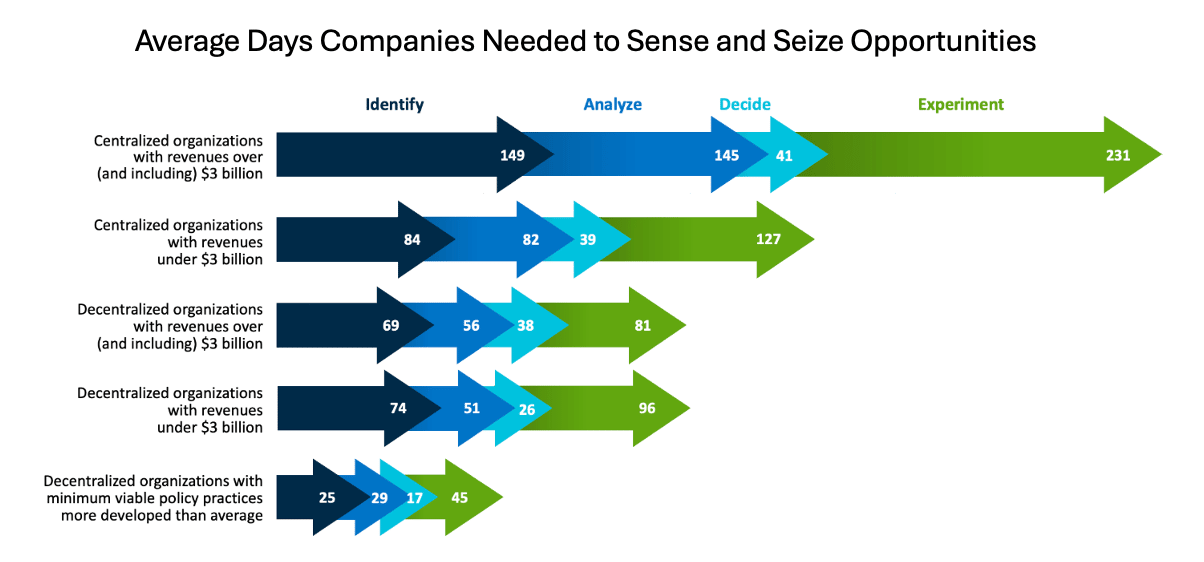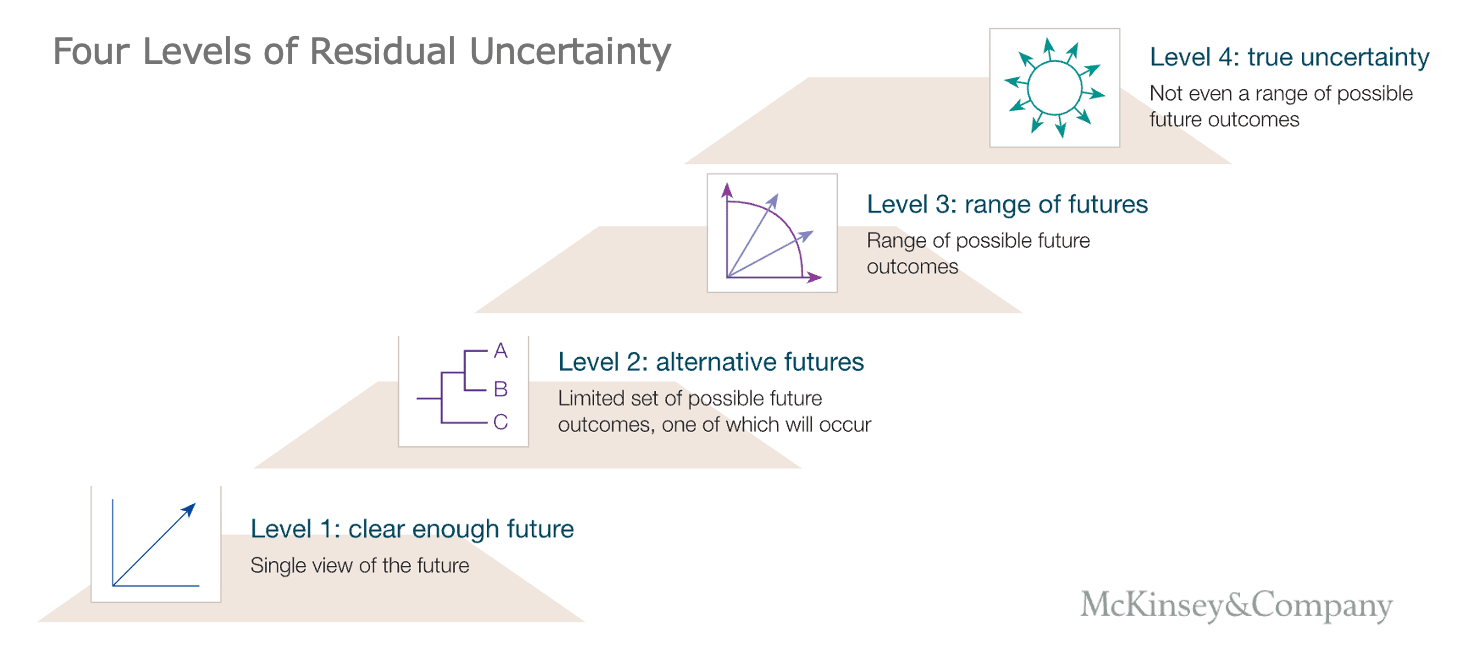Lead with Less Control

With digitalisation, interconnected and accelerated operations are driving new work design and processes. Leaders' decision-making must evolve to navigate unpredictable, fast-paced environments, to be able to respond to strategic shifts, competitive pivots, technological upgrades, and shorter timeframes.
“Decision making is the most important management activity, driving 95% of business performance and 50% of employee engagement.” Bain & Co research quoted by Erik Larson, Founder & CEO, Cloverpop.
Deciding Differently
During slower, more predictable times, decisions could be controlled centrally and made at the top after gathering and reviewing data. Leadership had established tools to use, relatively stable scenarios to project, and ample time to trial, tweak, and roll out plans. However, good decisions were still elusive:
- Only 28% of execs said strategic decision quality was 'generally good'.
- 60% found bad decisions were as frequent as good ones [HBR, 2010].
In a VUCA world, we need different mindsets and approaches, changing who is deciding what, how and when, shifting roles and distributing leaders' control. Here are three key areas to rework how decisions are made at your company:
#1 Decentralising Decision-making
In fast-shifting markets, leaders retaining control become business bottlenecks. Top leaders not close to the context can make decisions that are ill-informed, misaligned or lagging. Decisions crossing many layers are often uncompetitively slow. Any leadership "decision hubs” cause drag for your business.
For organisational agility, leaders can retain strategic decision rights—authority and accountability for what the business needs to achieve and why. They can distribute operational decision-making—authority and accountability for how best to achieve strategy goals—to those closer to the frontline and customers so they can identify, assess, and select opportunities. [MIT Digital Era survey]
“Decentralization enables a distributed and autonomous approach to decision-making and management, enabling an agile ecosystem” which is "adaptable and growth-oriented." Obaid Bokisha, COO e&, article Decentralized but not fragmented in WEF, June 2024.
Teams' involvement is critical in identifying, analysing, deciding and exploring ideas. Decentralised organisations reported net profit margins 6.2% and revenue growth 9.8% higher than large centralised counterparts [MIT CISR].

Decentralisation does not mean fragmentation, where tasks and decision-making are scattered and disconnected, but involves a flexible framework where autonomy and collaboration intersect effectively.
Consider a sports team model (noted in Create Context Not Chaos newsletter) where any high-performance team member has some control over their actions (autonomy) while the team works together (collaboration) towards a common goal. Decentralisation facilitates organisational agility enabling decisions based on specific situations, such as local market opportunities and customer needs.
"The success of decentralized decision-making hinges on the organization having a comprehensive organizational purpose: a multi-faceted statement that articulates why the organization exists by outlining future aspirations, value propositions, and core values." - MIT, Guiding Decision-making by Acting on Purpose, 2023.
#2 Determining Uncertainty Levels
Traditional decision-making approaches assume executives can predict the future of their business accurately enough to choose a clear strategic direction. With too many unknowns, underestimating uncertainty can easily hinder defence against threats and miss responses to emerging opportunities.
Systematic sound strategic decision-making under uncertainty requires determining the level of uncertainty with a tailored strategy for that level of uncertainty. Residual uncertainty—what remains after thorough analysis has been done—facing most strategic decision makers falls into one of four broad levels which can be approached using a four-part framework:

- Level 1: clear enough future - Residual uncertainty is not relevant. Managers can develop a precise enough single strategic forecast. A standard tool kit includes research, competitor analyses, and a DCF model to decide a suitable strategy.
- Level 2: alternative futures - A few discrete anticipated scenarios where analysis helps assess probability but not the outcome. Each scenario requires analysis and valuation. Tracking decision points and triggers is vital to determine quickly which outcome will occur. Regulation and competitors' actions often generate Level 2 situations.
- Level 3: range of futures - Limited key variables define the range within which the actual outcome may lie anywhere. There are no natural discrete scenarios but developing a manageable set of potential scenarios is necessary to assess alternative outcomes, analysing trigger events that can indicate progress toward one particular scenario.
- Level 4: true uncertainty - Many dimensions of uncertainty interact to make any prediction virtually impossible, even to identify or predict all relevant variables. A subset of variables may be determined for how the market will evolve with identifiable un/favourable indicators of these variables to track. Risks and returns of different strategies are not quantifiable but managers can identify data about the future to justify investments being considered. Level 4 used to be rare.
“Options should be rigorously reevaluated whenever important uncertainties are clarified and at least every six months." The key is to be "thinking rigorously and systematically about uncertainty." - McKinsey & Co, Strategy Under Uncertainty.
#3 Collaborating in Complexity
With new applications emerging and evolving that drive changing business dynamics and operations, decisions can have many layers and necessary interdependent inputs. These complexities include evolving priorities, technology advancements, human-centred issues, and economic uncertainties, affecting you, your team and workforce, and your prospects and customers.
Participation across internal silos is increasingly necessary to innovate at speed, while contributions and collaboration among generations has risen in importance to benefit from combining older leaders' experience with younger employees' tech expertise. More diversity of ideas and inputs improves results.
Participative decision-making significantly enhances cognitive flexibility, and impacts creativity and employee participation. Inclusive decision-making fosters innovation and adaptability at a time when soliciting and reviewing everyone's ideas is increasingly crucial to succeed [Participatory Decision-Making Research, 2025]
How comfortable are you with recent decisions made at your company?
Digital DNA

Human-centric workforce innovation in the age of AI
workforce and scale your business, navigating the fast-paced
unpredictable marketplace.
Generational EQ

Distributed Works

THIS WEEK’S TIP: HOW TO MAKE CHANGE
Teams don’t need tighter control; they need stronger connection.
You’re leading through uncertainty. Demands are high. Expectations keep shifting. Even the most capable team members are running low on energy.
How do you reenergize your team without burning yourself—or them—out?
The solution: focus on what really matters.
- Rebuilding trust and alignment across differences and distances
- Turning stress into purpose through connection and clarity
- Creating a culture where people contribute, not comply
It’s not about fixing your team but freeing them to perform at their best.
That’s exactly why I created Empowering High-Performing Teams. It’s not about adding another framework or fix. It’s about rediscovering what makes people work together well.
You might be one small shift away from the team you’ve always wanted.
Scaling Skills-first

Decision Blind Spots
What issues to pay attention to in shifting decision-making to ensure progress:
- Control masquerading as strong leadership limits growth
Many leaders steer most decisions thinking they 'know best' or want to 'stay safe.' During uncertain times, this becomes your lead constraint. - Delegation must be accompanied by clarity
You must define decision domains, escalation rules, and criteria for where employees have autonomy versus oversight. - Informational advantage lies in diversity
Younger employees with more tech-fluent, cross-disciplinary views may see patterns that older, siloed leaders miss - integrating everyone is key. - Different decision types require different rules
Categorising and analysing residual uncertainty is essential (see #2 above) to ensure appropriate decision-making approaches. - Siloed thinking amplifies issues
Autonomous groups can fall into echo chambers, making misaligned decisions unless guardrails and principles are well understood. - Investment in decision fluency and post-mortems
Decision-making is not intuitive. Scaling at speed requires discipline: post-decision reviews, data learning loops, and course corrections.
Intentional Decision Architecture
What you can do this week to be more deliberate and use updated processes to ensure suitably-informed and timely (fast or slower) decisions are made by:
- Map 10 decisions used in your organisation. Note down who currently makes each, how long it takes, what inputs/data flows.
- Identify bottlenecks — highlight two to three decisions that frequently back up because of escalation, lack of clarity, or review loops.
- Choose one decision to delegate — pick a mid-level decision, assign it to a team or manager with clear criteria and oversight.
- Run a “decision training sprint” — brief sessions on tradeoff heuristics, scenario thinking, and escalation triggers.
- Hold a retrospective — after the delegated decision, review outcomes and assumptions, gather lessons, and iterate.
Human-centric Leadership Audit

News & Muse

📘 Noise: A Flaw in Human Judgment - how to improve decision-making.
🗞️ Why managers should involve teams in the decision-making, HBR 2025.
📹 The Art of Decision-making, Annie Duke - how to hone your approach.
🎶 We're All in This Together, Ben Lee - accepting peer-based leadership.
The leaders who thrive in this new era are those who design decisions as systems, not bottlenecks. They trade authority for alignment, and control for capability. Every delegated decision empowers your teams to think — and greater collective intelligence becomes your competitive edge.
With my executive coaching, I enable executives to lead and oversee with greater confidence, clarity, and the systems-first mindset to adapt to modern work. My insights strengthen your leadership and C-suite impact and ensure your organisation both adapts and accelerates. Click here to book a 30-minute session.
Until next time!
Sophie
Scalable strategies. Tactical talk. Workforce transformation.
Human-centric workforce innovation in the age of AI
workforce and scale your business, navigating the fast-paced
unpredictable marketplace.
